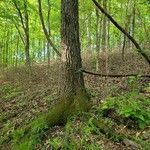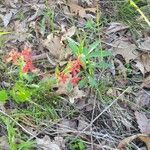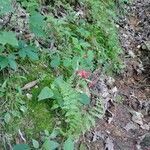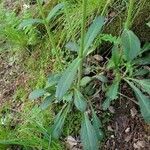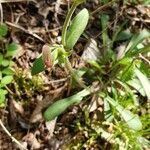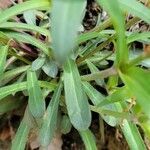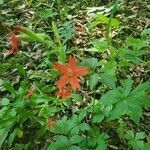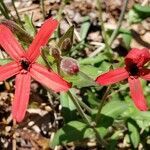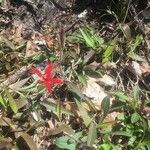Plants perennial; taproot slender; caudex decumbent, branched, producing tufts of leaves and erect flowering shoots. Stems simple proximal to inflo-rescence, 20-80 cm, glandular-pubescent, often subglabrous near base. Leaves: basal numerous, tufted, petiolate, petiole ciliate, blade oblanceolate, 3-10 cm × 8-18 mm, base spatulate, apex acute to obtuse, glabrous on both surfaces, rarely puberulent; cauline in 2-4 pairs, broadly petiolate to sessile, reduced distally, blade oblanceolate to narrowly elliptic or lanceolate, 1-10(-30) cm × 4-16(-30) mm, margins ciliate, apex acute, shortly acuminate, glabrous. Inflorescences open, with ascending, often elongate branches, (3-)7-11(-20)-flowered, bracteate, glandular-pubescent, often densely so, viscid; bracts leaflike, lanceolate, 4-40 mm. Pedicels erect in flower, sharply deflexed at base in fruit, 2-1 times length of calyx. Flowers: calyx green to purple, 10-veined, tubular to narrowly obconic in flower, 16-22 × 5-6 mm, clavate and swelling to 7-12 mm in fruit, glandular-pubescent, lobes lanceolate to oblong, 3-4 mm, margins usually narrow, membranous, apex acute or obtuse; corolla scarlet, 2 times longer than calyx, clawed, claw ciliate, gradually widening into limb, longer than calyx, limb obtriangular to oblong, deeply 2-lobed with 2 small lateral teeth, 10-14 mm, glabrous or nearly so, appendages 2, tubular, 3 mm; stamens exserted, shorter than petals; styles 3(-4), equaling stamens. Capsules ovoid, equaling calyx, opening by 3 (or 4) teeth that sometimes split into 6 (or 8); carpophore 2-3(-4) mm. Seeds ash gray, reniform, 1.5 mm, with large inflated papillae. 2n = 48.
More
Short-lived perennial, 2–8 dm, at least the stems glandular and puberulent; basal lvs oblanceolate or spatulate, 4–10 cm × 8–18 mm, petiolate; cauline lvs 2–4 pairs, sessile or nearly so, to 15 or even 30 cm and 3 cm wide; infl open, 7–11-fld, leafy-bracteate; cal broadly tubular, 18–22 mm; pet crimson, the tubular appendages 3 mm, the linear-oblong blade 15–22 mm, bilobed; carpophore 2(–4) mm; styles 3, capsule dehiscent by 6 teeth; 2n=48. Rich woods or open woodlands and rocky slopes; N.J. and w. N.Y. to s. Ont. and se. Mich., s. to Ga. and Okla. May–Sept.
